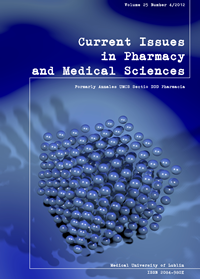Comparison of the physical properties of ointments, creams and gels with ibuprofen obtained with two different methods according to the own compositions
DOI:
https://doi.org/10.12923/j.2084-980X/25.4/a.09Słowa kluczowe:
ibuprofen, ointment, gel, cream, rheology, thixotropyAbstrakt
The aim of the study was preparing the skin formulations with ibuprofen as ointments, creams and gels. They have been prepared by two methods; melting the components and then mixing (method 1) and in the unqutor (method 2). The preparations have been tested rheologically and determined for the consistency, pH and spreadability ex tempore and after 3 months of storage at 4° C. The studies showed that the consistency is stable during all the time of storage. The pH values were within the tolerance of the skin. The formulations prepared in the unquator have better consistency, spreadability and lower viscosity.
Bibliografia
1. Aukunuru J., Bonepally C., Guduri V.: Preparation, characterization and optimization of ibuprofen ointment intended for topical and systemic delivery. Tropical Journal of Pharmaceutical Research, 6, 855-860, 2007.
2. British Pharmacopeia, Londyn, 2009.
3. Polish Pharmacopeia 9thedition, PZWL, Warsaw, 2011.
4. Gavrilin M.V., Ushakova S.L., Karpenya L.I.: Polymer-based ibuprofen ointment: synthesis, analysis and evaluation of biological activity. Pharmaceutical Chemistry Journal, 37, 31, 2003.
5. Kostowski W., Herman Z.S.: Farmakologia. Podstawy farmakoterapii. PZWL, wydanie III, tom I, Warszawa, 2007.
6. Kumar S.S., Rajkumar S., Ruckmani K.: Formulation and evaluation of ibuprofen loaded nanoparticles for improved anti- inflammatory activity. Acta Pharmaceutica Turcica, 45, 125-130, 2003.
7. Piechota-Urbańska M., Kołodziejska J., Zgoda M.M.: Lepkość farmakopealnych wielkocząsteczkowych podłoży maściowych a dostępność farmaceutyczna modelowego środka leczniczego. Polimery w medycynie, 37, 1-26, 2007.
8. Sundhamani T., Ganesan V., Priysdsrsini N., Radhakrishnan M.: Formulation and evaluation of ibuprofen loaded maltodextrin based proniosome. International Journal of Biopharmaceutics, 1, 75-81, 2010.
9. Sundhamani T., Noveenkumar K., Kumar V.R.R. et al.: Preparation and evaluation of ethyl cellulose microspheres of ibuprofen for sustsined drug delivery. International Journal of Pharm. Research and Development, 2, 119-125, 2010.
10. Urbańska-Piechota M., Kołodziejska J., Zgoda M.M.: Lepkość farmakopealnych wielkocząsteczkowych podłoży maściowych a dostępność farmaceutyczna modelowego środka leczniczego. Polimery w Medycynie, 37, 1-26, 2007.
11. Velasco D., Danoux Ch.B., Redondo J.A. et al.: pH-sensitive polymer hydrogels derived from morpholine to prevent the crystallization of ibuprofen. Journal of Controlled Release, 149, 140-143, 2011.
12. Watkinson R.M., Guy R.H., Hadgraft J. Lane M.E.: Optimisation of cosolvent concentration for drug delivery – II: influence of propylene glycol on ibuprofen permeation. Skin Pharmacology and Physiology, 22, 225-230, 2009.
13. Watkinson R.M., Herkenne C., Guy R.H. et al.: Influence of ethanol on the solubility, ionization and permeation characteristics of ibuprofen in silicone and human skin. Skin Pharmacology and Physiology 22, 15, 17, 2009.
14. Zgoda M.M., Kołodziejska J., Nachajski M.J.: Lepkość hydrożelowych produktów farmaceutycznych a szybkość procesu dyfuzji hydrotropowego połączenia ibuprofenu przez modelową granicę faz w warunkach in vitro. Polimery w Medycynie 37, 1-25, 2007.
Pobrania
Opublikowane
Numer
Dział
Licencja
Prawa autorskie (c) 2012 Autorzy

Praca jest udostępniana na licencji Creative Commons Attribution-NonCommercial-NoDerivatives 3.0 Unported License.


